The U.S. Bureau of Labor Statistics (BLS) released their monthly Consumer Price Index report on October 11th 2018, for the 12 month period through the end of September.
Annual Inflation is Down
- Annual inflation was down from 2.70% in August and 2.95% in July to 2.28% in September.
- CPI was 252.439 in September, 252.146 in August, 252.006 in July and 251.989 in June.
- Monthly Inflation for September was 0.12%, August was 0.06%, July was 0.01%, and June was 0.16% compared to 0.53% in September 2017.
- Next release November 14th
Monthly Inflation:
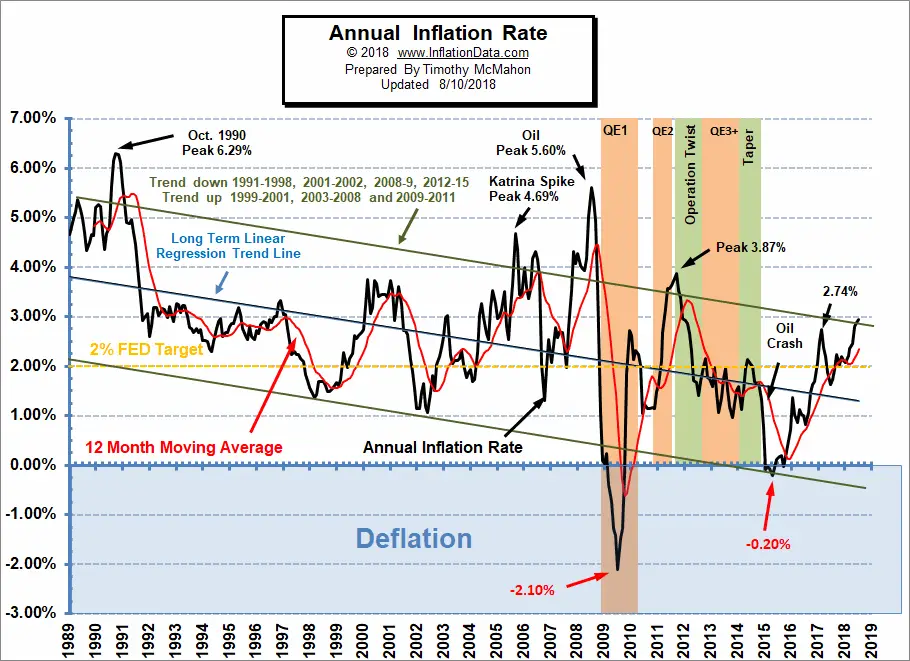
Annual inflation for the 12 months ending in September was 2.28% down from 2.70% in August.
“The Consumer Price Index for All Urban Consumers (CPI-U) increased 0.1 percent in September on a seasonally adjusted basis after rising 0.2 percent in August, the U.S. Bureau of Labor Statistics reported today. Over the last 12 months, the all items index rose 2.3 percent before seasonal adjustment. The shelter index continued to rise and accounted for over half of the seasonally adjusted monthly increase in the all items index. The energy index declined 0.5 percent in September after rising in August. The food index was unchanged in September, as an increase in the index for food away from home offset a decline in the food at home index.”
The following table shows the changes from September for the major categories in seasonally adjusted terms and for the entire 12 months in unadjusted terms.
From the table we can see that on a monthly Seasonally adjusted basis Used Cars and Trucks actually fell -3.0% and even Gasoline fell -0.2% while several other categories had minor gains. On an annual unadjusted basis however we see that Used Cars and Trucks are down -1.5% for the entire year and Gasoline is up 9.1%. Overall, energy is up 4.8% over the year and shelter is up 3.3%.
Typically the monthly inflation rate is highest during the first quarter (January through March) with April and May often being among the high months but not always.
The lowest monthly inflation is typically during the last quarter (October through December) with June through September typically being moderate.
Although the monthly differences seem relatively small, if we had 12 months of 0.42% inflation we would have 5.04% annual inflation but 12 months at 0.12% like we had in September would only result in 1.44% annual inflation. But when higher months are combined with lower inflation months and even some negative months the annual inflation becomes much lower. We can expect that the last quarter of this year will bring the inflation rate down further. See our Moore Inflation Predictor to see our current projections.
Regional Inflation Information
The U.S. Bureau of Labor Statistics also produces regional data. So if you are interested in more localized inflation information you can find it here.
Food and Energy Breakdown
The BLS publishes an index entitled “All items Less Food and Energy” which often causes people some confusion. It doesn’t mean they stopped including food and energy in the Consumer Price Index. It just means that they have broken them out so you can compare their increase to other components. In this chart we can see the effects of food, energy and all other items on the total index. For more info see What is Core Inflation?
Food
The food index was unchanged in September. The index for food at home, which was unchanged in August, fell 0.1 percent in September with major grocery store food group indexes mixed. The index for meats, poultry, fish, and eggs fell 1.0 percent in September, with all its major component indexes falling. The fruits and vegetables index also fell, declining 0.5 percent. The index for dairy and related products declined 0.3 percent.
Energy
The energy index declined 0.5 percent in September after rising 1.9 percent in August. After rising 3.0 percent in August, the gasoline index declined slightly in September, falling 0.2 percent. (Before seasonal adjustment, gasoline prices increased 0.3 percent in September.) The electricity index fell 0.5 percent in September after rising in August, and the index for natural gas, which also increased in August, fell 1.7 percent in September.
Misery Index
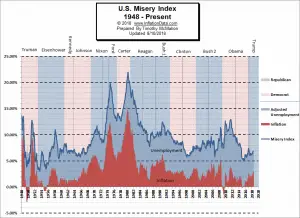
The misery index as of October 2018 (based on the most recent official government inflation and unemployment data for the 12 months ending in September) is at 5.98% down from 6.60% in August which was down from 6.85% in July, and 6.87% in June.
At 5.98%, the misery index is the lowest its been since August 2016 when it was 5.96%. However, beginning in September 2016, it jumped to 6.46% before peaking at 7.44% in February 2017.
But it is still less than half of the peak of 12.87% in both October and November 2011 which was pretty miserable. The Misery index is still well below the February 2017 peak of 7.44%. The average inflation rate since the beginning of the Misery Index in January 1948 is 3.53% which is still higher than current inflation levels… so if inflation were “average” the misery index would be higher.
[Read More…]
Moore Inflation Predictor
As you can see from the chart above, last month our MIP Chart was projecting a good size decrease and the actual line was right on target of our projection.
See Moore Inflation Forecast for this month’s projection.
NYSE Rate of Change (ROC)©
The stock market has taken a beating over the last month. Currently the NYSE ROC index is at roughly 0% for October indicating that the annual rate of return is nil. This is a difficult time to hold but…
See the NYSE ROC for more info.
NASDAQ Rate of Change (ROC)©
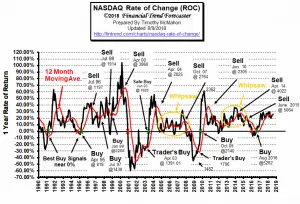 The NASDAQ continues to outperform the NYSE. NASDAQ ROC is well below its moving average, but the annual rate of return is still around 7%.
The NASDAQ continues to outperform the NYSE. NASDAQ ROC is well below its moving average, but the annual rate of return is still around 7%.
See NASDAQ ROC for more.
You Might Also Like:
From InflationData.com
- Can Crypto Solve Venezuela’s Hyperinflation Problem?
- Cost of Living: LA and New York vs. The World
- What Impact (if any) Does Disruption have on Inflation?
- Debt and Inflationary Pressures: A Lesson in Economic Interactivity
- Inflation Risk
- How Does Inflation Affect the Price of Gold?
- The Effects of Inflation and Interest Rates on Commodity Prices
Read more on UnemploymentData.com.
- Here’s Why “Strong Jobs” Don’t Mean “Higher Stocks”
- Unemployment Reaches Lowest Point Since 1969
- 5 Types of Jobs That Are Perfect for When You Can’t Decide Which Degree to Pursue
- Ways to Impress Clients Who Visit Your Office Space
- How to Infuse Your Business with Staying Power
From Financial Trend Forecaster
- Oil Price Rally Boosts Electric Car Sales
- $100 Oil Is A Distinct Possibility
- Do the FED’s Interest Rates Affect the Stock Market?
- Technological Solution to 100 Year Old Oil Problem
- Oil Price War: Saudi Arabia vs. Iran
- Coke, Meth And Booze: The Dark Side Of The Permian Oil Boom
- Why Graphene Hasn’t Taken Over the World- Yet
- New Oil Cartel Threatening OPEC
- The Psychology of Volatility
- What is the Up/Down Volume Saying About the Current Market?
- This Doesn’t Happen in Bear Markets
- Is Gold on the Verge of a Bottom?
- Moving Averages Help You Define Trend – Here’s How
- Charts Say Stocks Could Rise For 10-15 Years
- Latest Economic Data Doesn’t Align with Yield Curve Fears
- The Stock Market Big Picture
- Using Longer Timeframes To Combat Volatility Fatigue
From OptioMoney.com
- 5 Ways to Reduce Your Business Credit Risk
- How Does a Surety Bond Differ from Insurance?
- When is the Right Time to Buy Life Insurance?
- 4 Things Home Buyers Shouldn’t Do During the Mortgage Process
- Tips for Avoiding Cash Crunches and Managing Cash Flow in Business
- How to Survive Bankruptcy
- How to Lower the Chances of Bankruptcy as a Personal Business Owner
- How to Handle Medical Bill Debt
- The Costs of Moving: 4 Thrifty Tips to Keep Your Next Move Cheap
- How Smart Entrepreneurs Manage and Insure Their Assets
From Your Family Finances
- 4 Tips to Better Managing Your Finances and Assets
- Retiring to the Mountains: Enjoying Your Retirement
- Manage Your Money for Recreation and Fun
- The Importance of Insurance
- Is an FHA Loan Right for You?
- Budgeting for Upcoming Purchases and Goals
- Financial Hard Times: How to Pull Your Family out of Debt
- Are Your Water Bills “Eating You Alive”?
- 3 Ways Keeping Tabs on Your Credit Helps More Than Just Your Finances
- A Guide to: Making the Most of Cash Back Rewards Credit Cards
- How to Start and Build a Valuable Coin Collection
- Consistency Should Be Your Financial Foundation

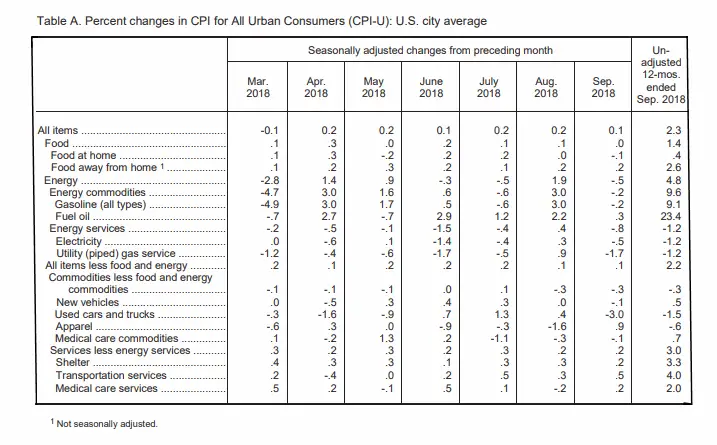
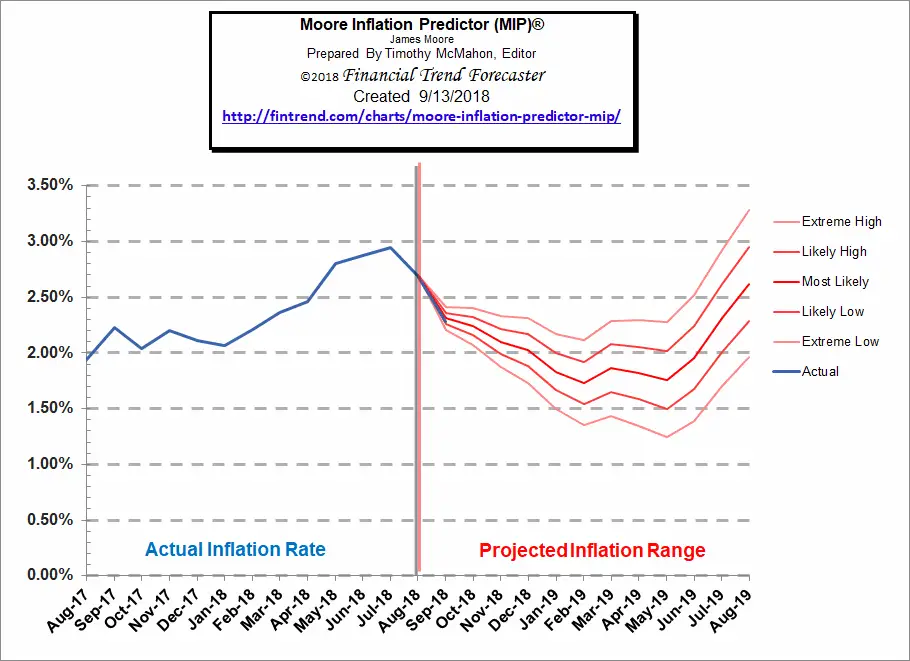
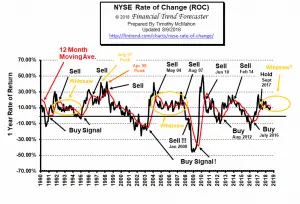

Leave a Reply